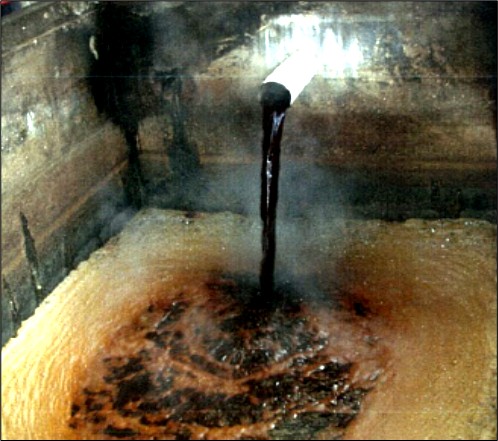ศักยภาพการผลิตชีวภาพมีเทนจากน้ำกากส่าของโรงงานสุรากลั่นชุมชนโดยกระบวนการย่อยสลายร่วมแบบไร้อากาศกับกากน้ำตาล
DOI:
https://doi.org/10.55164/jgrdi.v1i1.704คำสำคัญ:
การผลิตก๊าซชีวภาพ, การย่อยสลายแบบไร้อากาศ, น้ำกากส่า, กากน้ำตาลบทคัดย่อ
งานวิจัยนี้ศึกษาศักยภาพการผลิตมีเทนของน้ำกากส่าโรงงานสุรากลั่นชุมชนด้วยกระบวนการหมักร่วมแบบไร้อากาศกับกากน้ำตาลภายใต้อุณภูมิ 35 ๐C ซึ่งอัตราส่วนของการหมักร่วมระหว่างน้ำกากส่า : กากน้ำตาล คือ 99 : 1 98 : 2 97: 3, 96 : 4 และ 95 : 5 ผลการทดลองพบว่าอัตราส่วนที่เหมาะสมที่ให้ผลได้มีเทนและผลิตมีเทนสูงสุด คือ อัตราส่วนร้อยละ 99 : 1 (2.92 g COD) มีค่าเท่ากับ 334 ml CH4/g COD หรือ 17 m3 CH4/m3 Wastewater ตามลำดับ ก๊าซชีวภาพมีความเข้มข้นของมีเทนอยู่ในช่วงร้อยละ 55-70 และมีความเข้มข้นมีเทนเฉลี่ยร้อยละ 62.5 การวิเคราะห์การเสริมกันของการหมักร่วมน้ำกากส่าโรงงานสุรากลั่นชุมชนกับกากน้ำตาลพบให้ผลได้มีเทนสูงสุดที่อัตราส่วนร้อยละ 99 : 1 มีผลได้มีเทนเพิ่มขึ้น 69 ml CH4/g COD ในกระบวนการหมักร่วมสามารถปรับค่าอัตราส่วนคาร์บอนต่อไนโตรเจนของน้ำกากส่าให้สูงขึ้นจาก 14.39 เป็น 25.09 ด้วยการหมักร่วมน้ำกากส่ากับกากน้ำตาลที่อัตราส่วนร้อยละ 99 : 1 ส่งผลให้ศักยภาพการผลิตมีเทนเพิ่มขึ้น
เอกสารอ้างอิง
Thai Industrial Standards Institute (TISI) (2016). List of people who have been certified by community product standards 32/2546 community distilled liquor. Bangkok, Ministry of Industrial, Retrieved on 5 January 2023, from https://www.tisi.go.th/website/about/tisi_cps
Chanpalakorn, C. (2008). Effect of cod loading rate on biogas production from distillery slop wastewater by anaerobic baffled reactor. [Master’s thesis, Chulalongkorn University]. Chulalongkorn University Library. http://cuir.car.chula.ac.th/handle/123456789/16127
National Energy Policy Office (NEPO). (2000). Study report on biomass power plants of small rural industries. Black & Wish (Thailand) Co., Ltd. 1-78.
Ma, J., Wambeke, M. V., Carballa, M. & Verstraete W. (2008). Improvement of the anaerobic digestion of potato processing wastewater in a UASB reactor by co-digestion with glycerol, Biotechnology Letters. 30(5), 861-867. https://doi.org/10.1007/s10529-007-9617-x
Wong, Y. S., Teng, T. T., Ong, S. A., Norhashimah, M., Rafatullah, M. & Leong, J. Y. (2014). Methane gas production from palm oil wastewater-An anaerobic methanogenic degradation process in continuous stirrer suspended closed anaerobic reactor, Journal of the Taiwan Institute of Chemical Engineers. 45(1), 896-900. https://doi.org/10.1016/j.jtice.2013.10.002
Wasterholm, M., Hansson, M., & Schnurer A. (2012). Improved biogas production from whole stillage by co-digestion with cattle manure. Bioresource Technology, 114, 314-319. https://doi.org/10.1016/j.biortech.2012.03.005
Tang, Y.Q., Fujimura, Y., Shigematsu, T., Morimura S. & Kida, K. (2007). Anaerobic treatment performance and microbial population of thermophilic upflow anaerobic filter reactor treating awamori distillery wastewater, Journal of Bioscience and Bioengineering. 104(4), 281-287. https://doi.org/10.1263/jbb.104.281
Kangle, K. M., Kore, S. V., Kore, V. S., & Kulkarni, G. S. (2012). Recent trends in anaerobic co-digestion: a review, Universal Journal of Environmental Research and Technology. 2(4), 210-219.
Koupaie, E. H., Leiva, M. B., Eskicioglu, C., & Dutil, C. (2014). Mesophilic batch anaerobic co-digestion of fruit-juice industrial waste and municipal waste sludge: process and cost-benefit analysis, Bioresource Technology. 152(1), 66-73. https://doi.org/10.1016/j.biortech.2013.10.072
O-Thong, S., Boe, K. & Angelidaki, I. (2012). Thermophilic anaerobic co-digestion of oil palm empty fruit bunches with palm oil efficient biogas production, Applied Energy. 93(C), 648-654. https://doi.org/10.1016/j.apenergy.2011.12.092
Lee, J. Y., Yun, J., Kim, T. G., Wee, D. & Cho, K. S. (2014). Two-stage biogas production by co-digesting molasses wastewater and sewage sludge, Bioprocess Biosystems Engineering, 37(12), 2401-2413. https://doi.org/10.1007/s00449-014-1217-2
American Public Health Association (APHA). (2012). Standard methods for the examination of water and wastewater, In Rice, E. W., Baird, R. B., Eaton, A. D. and Clesceri, L. S. (Eds.) (pp. 1-1220). USA: Washington D.C.
Angelidaki, I., Alves, M., Bolzonella, D., Borzacconi, L., Campos, J.L., Guwy, A. J., Kalyuzhnyi, S., Jenicek, P. & van Lier, J. B. (2009). Defining the biomethane potential (BMP) of solid organic wastes and energy crops: a proposed protocol for batch assays, Water Science & Technology. 59(5), 927-934. https://doi.org/10.2166/wst.2009.040
Krajahean, P. (2009). Utilization of distillery slop for hydrogen production. [Unpublished master's thesis]. Kasetsart University.
Álvarez, J. A., Otero, L. & Lema, J. M. (2010). A methodology for optimizing feed composition for anaerobic co-digestion of agro - industrial wastes, Bioresource Technology. 101(4), 1153-1158. https://doi.org/10.1016/j.biortech.2009.09.061

ดาวน์โหลด
เผยแพร่แล้ว
รูปแบบการอ้างอิง
ฉบับ
ประเภทบทความ
สัญญาอนุญาต
ลิขสิทธิ์ (c) 2023 บัณฑิตวิทยาลัย มหาวิทยาลัยทักษิณ

อนุญาตภายใต้เงื่อนไข Creative Commons Attribution-NonCommercial-NoDerivatives 4.0 International License.


